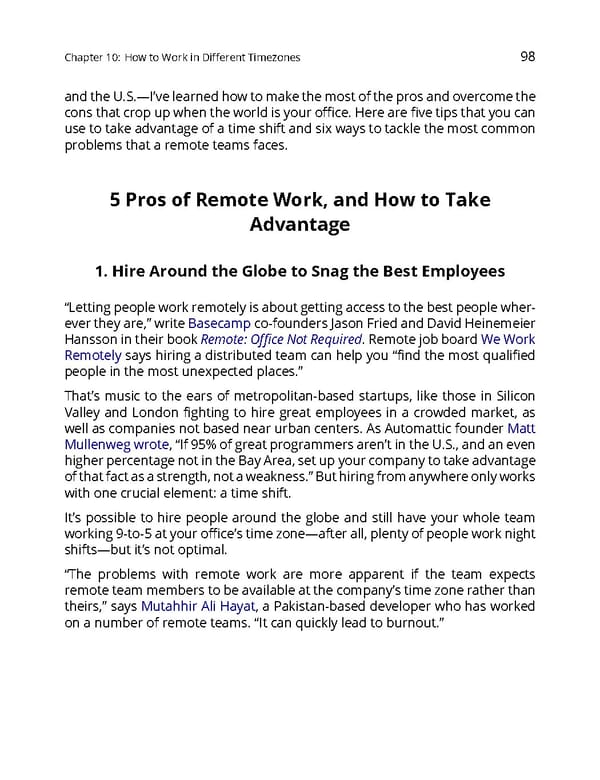Chapter10: HowtoWorkinDifferentTimezones 98 andtheU.S.—I’velearnedhowtomakethemostoftheprosandovercomethe consthatcropupwhentheworldisyouroffice.Herearefivetipsthatyoucan usetotakeadvantageofatimeshiftandsixwaystotacklethemostcommon problemsthataremoteteamsfaces. 5ProsofRemoteWork,andHowtoTake Advantage 1. Hire Around the Globe to Snag the Best Employees “Letting peopleworkremotelyisaboutgettingaccesstothebestpeoplewher- evertheyare,”writeBasecampco-foundersJasonFriedandDavidHeinemeier HanssonintheirbookRemote:OfficeNotRequired.RemotejobboardWeWork Remotely says hiring a distributed team can help you “find the most qualified peopleinthemostunexpectedplaces.” That’s music to the ears of metropolitan-based startups, like those in Silicon Valley and London fighting to hire great employees in a crowded market, as well as companies not based near urban centers. As Automattic founder Matt Mullenwegwrote,“If95%ofgreatprogrammersaren’tintheU.S.,andaneven higherpercentagenotintheBayArea,setupyourcompanytotakeadvantage ofthatfactasastrength,notaweakness.”Buthiringfromanywhereonlyworks with one crucial element: a time shift. It’s possible to hire people around the globe and still have your whole team working9-to-5atyouroffice’stimezone—afterall,plentyofpeopleworknight shifts—but it’s not optimal. “The problems with remote work are more apparent if the team expects remoteteammemberstobeavailableatthecompany’stimezoneratherthan theirs,” says Mutahhir Ali Hayat, a Pakistan-based developer who has worked onanumberofremoteteams.“Itcanquicklyleadtoburnout.”
 The Ultimate Guide to Remote Work Page 101 Page 103
The Ultimate Guide to Remote Work Page 101 Page 103